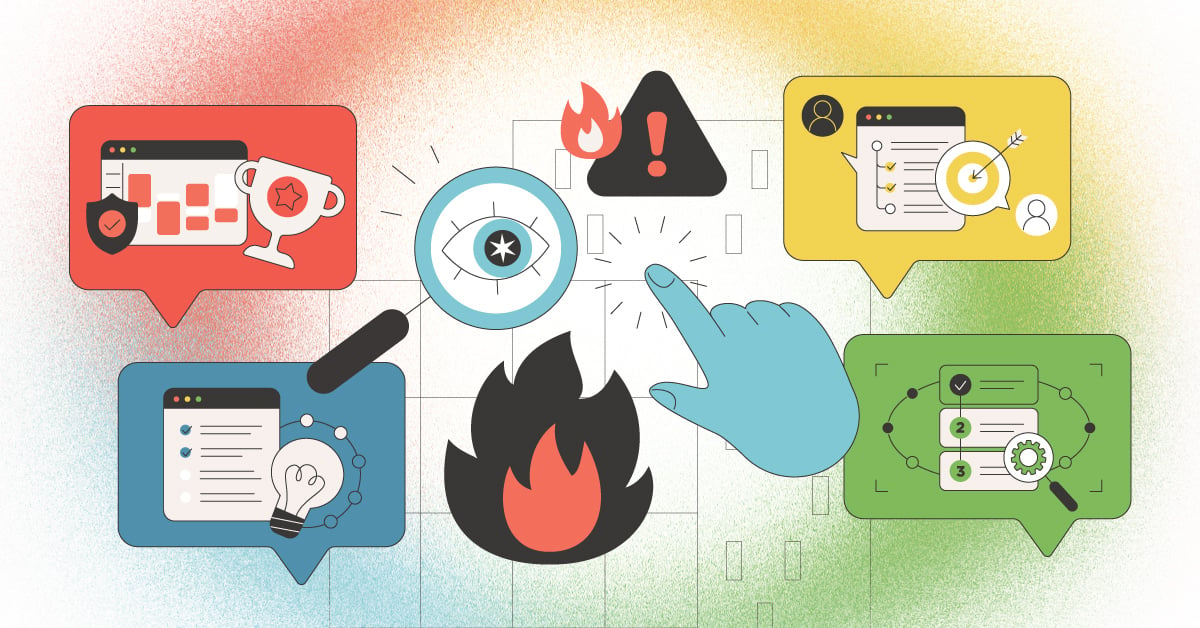
There are a lot of benefits to implementing a hybrid team for your organization; better work life balance, flexibility for team members, and less necessary office space. Many organizations started working remotely in 2020, but that doesn’t mean you nailed it on the first try.
If your workplace is adapting to a hybrid work environment in 2021, you’re going to need to readjust yet again while part of your team returns to an office while others remain at home. How will each individual react to these changes?
We’ve shared about how each DISC type can adapt under stress, as well as what happens when they are under normal, moderate, and extreme pressure. Here’s what each DISC behavior needs on a hybrid team.
Direct: Create a Clear Structure
![]() Without clear instructions and check ins, High Ds can go off the rails and move at a breakneck pace. Direct communicators like task-oriented work and achieving high goals they set for themselves, but their tendency to bounce around on tasks can cause their team members to feel left in the dust.
Without clear instructions and check ins, High Ds can go off the rails and move at a breakneck pace. Direct communicators like task-oriented work and achieving high goals they set for themselves, but their tendency to bounce around on tasks can cause their team members to feel left in the dust.
Solution:
Use a scheduling team tool like Basecamp or Monday to lay out entire projects that break down into tasks. That way, High Ds can stay on tasks and work at their rapid, preferred pace without leaving their team behind.
Encourage everyone to share exactly what parts of projects they’re working on, and build these checkpoints into projects. If reporting is just another step in the process, it won’t feel intrusive to Direct communicators while still remaining efficient.
Reflective: Over-Communicate for Excellence
![]() Low Ds hate conflict and prefer to keep the peace. This can be a struggle on a hybrid team, where some team members can benefit from face-to-face communication while others can only rely on video chat and text chat. When communication isn’t happening in-person, low Ds can panic and become anxious.
Low Ds hate conflict and prefer to keep the peace. This can be a struggle on a hybrid team, where some team members can benefit from face-to-face communication while others can only rely on video chat and text chat. When communication isn’t happening in-person, low Ds can panic and become anxious.
Solution:
While much of this anxiety must be self managed, you can prevent miscommunication in the first place. Make sure to schedule one-on-ones with your Reflective team members and express gratitude to them on a regular basis.
Offer constructive criticism but follow it up with a reassurance that their hard work is noticed. This is important for all team members, but especially for low Ds, who will not go out of their way to get feedback or ask for feedback.
Outgoing: Better Bonding = Better Work
![]() Outgoing communicators have a high I score, which means they are people-oriented, talkative and driven by interaction. High Is have likely suffered heavily while remotely; without water cooler talk, coffee breaks, office inside jokes and regular chances to connect with others, Outgoing communicators wither. They also are at risk of leaving others out unintentionally if they work with some team members in-person.
Outgoing communicators have a high I score, which means they are people-oriented, talkative and driven by interaction. High Is have likely suffered heavily while remotely; without water cooler talk, coffee breaks, office inside jokes and regular chances to connect with others, Outgoing communicators wither. They also are at risk of leaving others out unintentionally if they work with some team members in-person.
Solution:
Have team bonding that is actually fun. Zoom cocktails have lost their appeal to many, so don’t make your team gather in the same way they do for meetings. Try playing a collaborative online game like Among Us or Overcooked, or have a lunch-hour watch party for a show your team loves.
Something entirely unrelated to work will help everyone feel like they’re together again. That feeling goes a long way with Outgoing communicators.
Reserved: Focus On Clarity
![]() While you’re thinking of the miscommunication that happens in hybrid teams, Reserved communications are definitely feeling that pressure. They are highly analytical individuals, and that eye to detail can cause them to read too much into written messages or even the small things like emoji choice in Slack.
While you’re thinking of the miscommunication that happens in hybrid teams, Reserved communications are definitely feeling that pressure. They are highly analytical individuals, and that eye to detail can cause them to read too much into written messages or even the small things like emoji choice in Slack.
Solution:
Many people got used to remote communication in 2021, but that doesn’t mean they’re ready for hybrid teams. Make sure all team members are receiving the same amount of attention and information when tackling projects, noting successes, and giving feedback. Avoid sarcasm or any kind of figurative language that can be misinterpreted over chat.
Reserved communicators won’t go out of their way to ask for clarification or more feedback, but when they receive those things, it enforces what they know about their work situation and will help them feel more secure.
Steady: Slower Pace, Increased Anxiety
![]() Steady communicators prefer a slow pace, defined responsibilities, and clearly outlined expectations. The pace can clip on a hybrid team, and there might be anxiety around reaching out to clarify expectations, especially if part of the team is remote and part is in-office.
Steady communicators prefer a slow pace, defined responsibilities, and clearly outlined expectations. The pace can clip on a hybrid team, and there might be anxiety around reaching out to clarify expectations, especially if part of the team is remote and part is in-office.
Solution:
Steady people want the opportunity to think through their projects multiple times, with their team and on their own. Make sure that expectations and instructions aren’t just delivered verbally; follow up with an email with deliverables and utilize your project management software. It might feel like overkill at times, but this process will save you a lot of time when your High S teammates can make sure they’re on track on their own.
Make sure to get their input on the schedule of a project as much as possible. If you’re simply dictating due dates and project pace, your Steady team members will feel overwhelmed and ignored; ask them what feels reasonable for deliverables and come to a compromise. This work upfront is worth it for success throughout the project and will increase their engagement in their work.
Dynamic: Moving Too Fast
![]() Dynamic people, or Low Ss, love jumping from idea to project to task, without slowing down. This high-energy approach can cause problems when the obstacles of a hybrid team come into play — different time zones, working away from chat, not being able to pop into someone’s office for the answer they need quickly.
Dynamic people, or Low Ss, love jumping from idea to project to task, without slowing down. This high-energy approach can cause problems when the obstacles of a hybrid team come into play — different time zones, working away from chat, not being able to pop into someone’s office for the answer they need quickly.
Solution:
Even if instant chat is an option, people can’t always immediately reply. Establish communication requirements and preferences early on in your working relationships on hybrid teams, i.e “Slack me for regular requests, email for more formal questions, and text me in an emergency”.
These expectations will help lessen the anxiety about being ‘on’ all day for the rest of your team, but they will help Dynamic communicators prepare for how and when they get information from others. Also, make sure your Low Ss have plenty of tasks to work on at once, so they can jump around without disrupting other projects.
Precise: Adjusting to Others
![]() Precise communicators (High Cs) enjoy rules and clear expectations but don’t love hashing things out with others. This means they can overly rely on tools like chat and email while avoiding phone calls and video chat. This can cause a disconnect with other communicators who need some face time, and if they work on a hybrid team, they can retreat even further without regular team interaction.
Precise communicators (High Cs) enjoy rules and clear expectations but don’t love hashing things out with others. This means they can overly rely on tools like chat and email while avoiding phone calls and video chat. This can cause a disconnect with other communicators who need some face time, and if they work on a hybrid team, they can retreat even further without regular team interaction.
Solution:
Use different communication formats for different purposes. If you have a quick question, shoot off a chat, but use video chats for project launch meetings and one-on-ones. Remember that helping your High Cs push themselves out of their comfort zones will have positive benefits for their growth and their standing within your team!
That being said, let Precise communicators select their preferred communication method as often as possible. Lessening sources of stress is key to increasing engagement, and the less friction on your hybrid team, the better.
Pioneering: Too Free Spirited
![]() Pioneering communicators have a low C score, and they love forging their own path, but that can lead to troubles with a hybrid team. If they are enjoying the flexibility of working from home a little too much, the team might not be able to grab them at crucial moments. Their flexibility with communication formats and style might also confuse and discourage more rigid peers.
Pioneering communicators have a low C score, and they love forging their own path, but that can lead to troubles with a hybrid team. If they are enjoying the flexibility of working from home a little too much, the team might not be able to grab them at crucial moments. Their flexibility with communication formats and style might also confuse and discourage more rigid peers.
Solution:
If you’re a low C and need time to think, plan, or simply get stuff done, mark it on your calendar clearly. If your best work comes after hours or before you’re on the clock, indicate that on your calendar and don’t be afraid to let your team know that preference. However, you need to be available on your ‘on hours’, so don’t check out, but do communicate your process and find a middle ground.
If you’re managing a Pioneering communicator, help them figure out their communication cadence and productivity. Take advantage of their free-thinking and outside the box approach to find creative solutions, but remind them that paying attention to their team members is just as important.
Succeed With All Communication Styles
Overall, there are 3 things you need to do for success with all communicators on hybrid teams.
Over-Communicate
With your team partially at home and in-office, you need to make sure that everyone is always on the same page. Make sure the information they need is available over the phone, in-person, and over your shared project management system. If it feels like overkill, you’re doing it right.
Over-Clarify
A lot of people experienced high levels of anxiety and uncertainty when transitioning to remote work, and that uncertainty can carry over into working on a hybrid team. Offer consistent feedback and make sure that your team has the channels they need to express themselves and any concerns. Clear up KPIs and reinforce job descriptions (the benchmarking process can be particularly helpful for this task!).
Over-Appreciate
When we say over-appreciate, we don’t mean that you need to be full of simpering praise all of the time. It’s important to remember that the risk of disconnect and disengagement is higher for hybrid teams if they are not managed properly. Use the knowledge you have about each of your team members’ preferences to show them you appreciate their hard work and effort.
Hybrid teams are the likely future of the workplace. Use your knowledge of your team’s communication styles to help them succeed in their roles as soon as possible!
Wondering what your DISC communication style is? Take the free Working From Home Report and find out!



![Don’t Let Your Behavioral Style Haunt You [Infographic]](https://blog.ttisi.com/hubfs/Halloween-Infographic_DontLetYourBehavioralStyleHauntYou_Email_Header.png)
